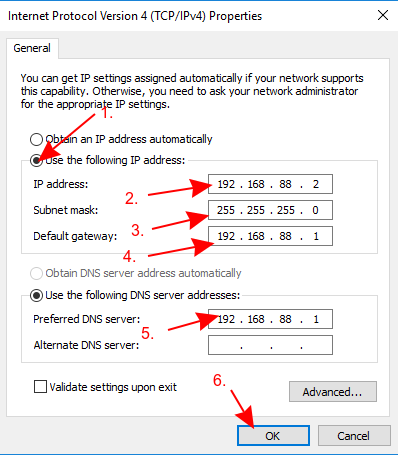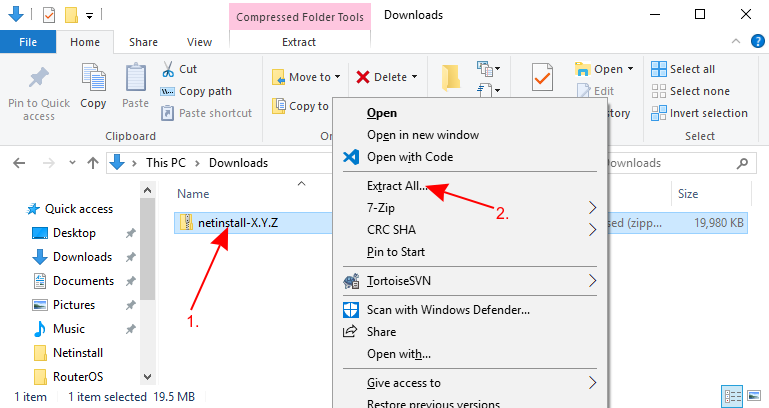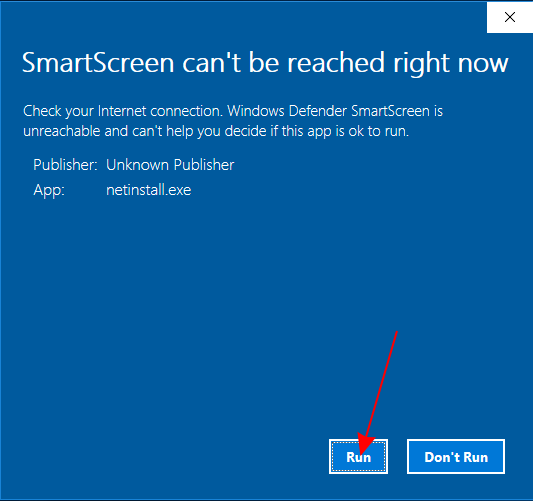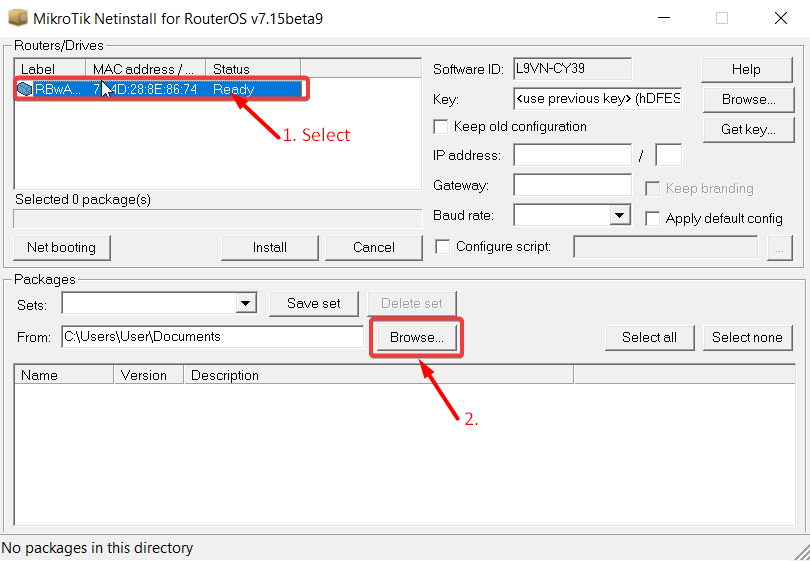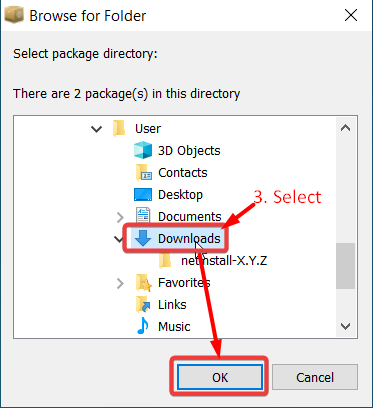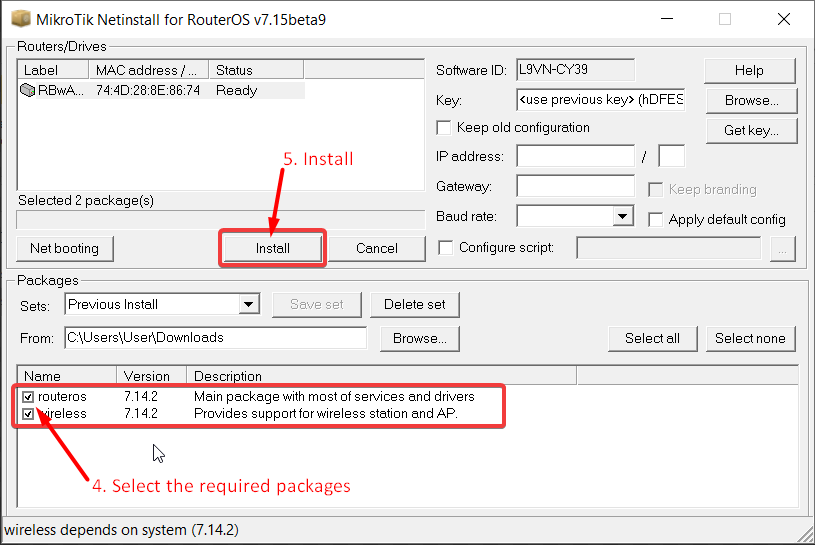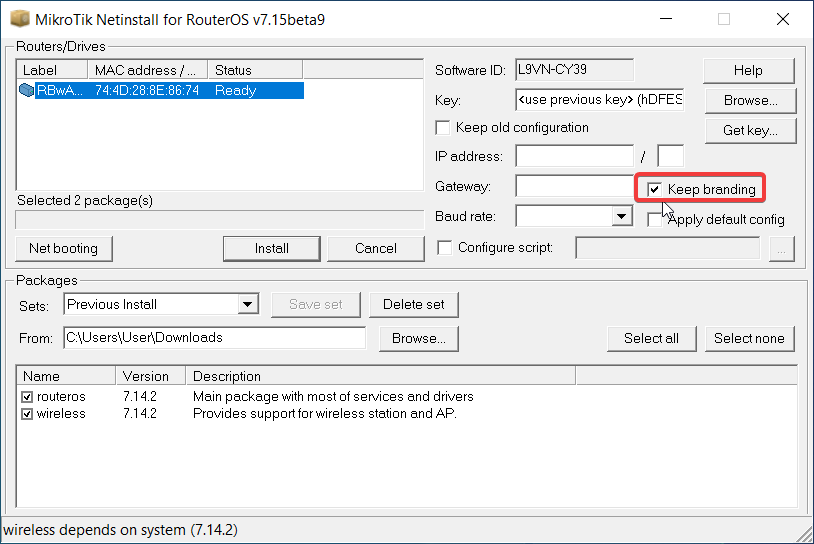...
Instructions for Windows
- Download Netinstall the Stable or Testing version of the Netinstall utility from the downloads page. If you are not sure which version you need, then you can always select the version that is marked as Current (stable);
Download the RouterOS Main package from the downloads page;
Tip You must choose need to select a RouterOS version. You can always select the version that is , preferably one marked as Current. You must also select the Stable. Additionally, choose the appropriate architecture (ARM, MIPS, SMIPS, TILE, etc...), but if you are not sure, then ). If unsure, you can download the RouterOS package for ALL all architectures, and Netinstall will choose determine the right architecture for youcorrect one for your device.
Disable all of your computer network interfaces (WiFi, Ethernet, LTE, or any other type of connection) besides except for the one which will to be used for installation! . Netinstall will only work on function with one active interface on your computer, it is highly recommended that you disable . It's strongly recommended to deactivate any other network interfaces in order to be sure that Netinstall will select the right network interfaceensure Netinstall selects the correct one.
Configure a static IP address for your Ethernet interface, open Start, and select Settings:
...
- Check Use the following IP address and fill out the fields as shown in the image below
| Note |
|---|
If you have a working router, then you can use it and skip the setting up a static IP part of this tutorial, but it requires you to know your LAN address since you will need to specify an unused IP address in your network for the network boot server. For this reason, it is recommended to apply a static IP address and follow this guide precisely, if you are not sure how to get these parameters out of your network. |
- Open your Downloads folder (or wherever you saved the downloaded files) and extract the Netinstall .zip file to a convenient place
Make sure that the Ethernet interface is running and launch Netinstall.exe. If you followed the guide precisely, then you should not have any Internet connection on your computer, Windows 10 wants to verify all apps that it runs, but will not be able to do it since lack of an Internet connection, for this reason, a warning might pop up, you should click Run.
| Warning |
|---|
Netinstall requires administrator rights, there should be a window asking for permissions to run Netinstall, you must accept these permissions in order for Netinstall to work properly. |
- Open your Downloads folder (or wherever you saved the downloaded files) and extract the Netinstall *.zip file to a convenient place
Make sure that the Ethernet interface is running and launch Netinstall.exe. If you followed the guide precisely, then you should not have any Internet connection on your computer, Windows 10 wants to verify all apps that it runs, but will not be able to do it since lack of an Internet connection, for this reason, a warning might pop up, you should click Run.
| Warning |
|---|
Netinstall requires administrator rights, there should be a window asking for permissions to run Netinstall, you must accept these permissions in order for Netinstall to work properly. |
- Allow access for Netinstall in Public Allow access for Netinstall in Public networks and configure Net booting settings and fill out the required fields as shown in the image below
...
- Connect your device to your computer using an ethernet cable directly (without any other devices in-between), plug the Ethernet cable into your device's Etherboot port.
- MikroTik devices are able to use Netinstall from their first port (Ether1), or from the port marked with "BOOT".
| Warning |
|---|
Some computers have a network interface (especially USB Ethernet adapters) that tend to create an extra link flap, which is enough for Netinstall to fail to detect a device that is in Etherboot mode. In such a case you can use a switch between your device and your computer or a router in bridge mode to prevent this issue. Netinstall uses bootp packets, which are using the same port numbers as DHCP packets. If you're using a switch between your PC and the device to be Netinstalled, ensure that the ports in the bridge are not blocked by other network devices. If you have dhcp-snooping enabled, make sure to enable "trusted" on the bridge ports facing the Netinstall PC. |
...
| Tip |
|---|
There are multiple ways how to put your device into Etherboot mode. Make sure you read the Etherboot manual Etherboot manual before trying to put the device into this mode. Methods vary between different MikroTik devices. |
- Wait for the device to show up in Netinstall, then select it and pressclick Browse. Navigate to your Downloads folder (or wherever you saved your RouterOS packages) and press OK.
...
- Select your desired RouterOS version packages and press Install. Wait for the installation to finish and press "Reboot" (Devices without serial console have to be rebooted manually).
| Note |
|---|
If you have downloaded RouterOS packages for multiple architectures, then Netinstall will only show display the appropriate architecture packages for your device after you have selected it. All unsupported Unsupported packages will not show up appear in this window after you have selected once a device is selected. |
...
If the installation does not start (progress bar is not moving or no status is shown), then you can try closing the Netinstall application and opening it up again or try to put the device into Etherboot mode again. If you are still unable to get Netinstall working, then you should try using it on a different computer since there might be an operating system's issue that is preventing Netinstall from working properly.
- You are done! Remove the device from power, remove the Ethernet cable, place the device back in your network and your device should be running properly now!
| Note |
|---|
The "Keep old configuration" process involves downloading the configuration database from the router, reinstalling the router (including disk formatting), and uploading the configuration files back to it. However, it's important to note that this process solely applies to the configuration itself and does not impact the files, including databases like the User Manager database, Dude database, and others. |
After using Netinstall the device will be reset to defaults (unless you specified not to apply default configuration). Some devices are not accessible through ether1 port with the default configuration for security reasons. Read more about Default configuration.
...
Option "Keep branding"
...
allows you to retain the device's already installed branding package without reinstalling it using Netinstall.
| Note |
|---|
The "Keep old configuration" process involves downloading the configuration database from the router, reinstalling the router (including disk formatting), and uploading the configuration files back to it. However, it's important to note that this process solely applies to the configuration itself and does not impact the files, including databases like the User Manager database, Dude database, and others. |
| Tip |
|---|
When using the Configure script option, it is suggested to introduce a delay before configuration execution. Configure script pre-configures the device with the provided configuration (text file in .RSC format). This configuration also takes place of the default configuration. The script can access factory passwords with read-only variables $defconfPassword and $defconfWifiPassword (starting from RouterOS 7.10beta8). |
Instructions for Linux
The Linux version is a command line tool, which offers nearly the same parameters as the Windows counterpart.
Download the tool from our download page (links not literal):
wget https://download.mikrotik.com/routeros/[VERSION]/netinstall-[VERSION].tar.gzExtract it:
tar -xzf netinstall-[VERSION].tar.gzRun the tool:
| Tip |
|---|
When using the Configure script option, it is suggested to introduce a delay before configuration execution. |
- You're all set! Configure your device and reconnect it to your network. Your device should now be functioning correctly!
Instructions for Linux
The Linux version is a command line tool, which offers nearly the same parameters as the Windows counterpart.
Download the tool from our download page (links not literal):
wget https://download.mikrotik.com/routeros/[VERSION]/netinstall-[VERSION].tar.gzExtract it:
tar -xzf netinstall-[VERSION].tar.gzRun the tool:
./netinstall-./netinstall-cli -a 192.168.0.1 routeros-arm64-[VERSION].npk
...
The available parameters are as follows:
| Parameter | Meaning |
|---|---|
| -r | When the reinstallation process is performed, the current configuration is will be reset, and for devices that have it, the default configuration will be applied . (optional). |
| -e | When Performing the reinstallation process is performed will reset the device to an empty configuration. |
| -b | Option to discard the currently installed branding package from the device, otherwise it will be reinstalled together with RouterOS. |
| -k keyfile | Provides the device with a license key in .KEY format . (optional). |
| -s userscript | Pre-configures the device with the provided configuration (text file in .RSC format). This configuration also takes place of the default configuration. The script can access factory passwords with read-only variables $defconfPassword and $defconfWifiPassword (starting from RouterOS 7.10beta8). (optional). |
-a IP | Uses a specific IP address that the Netinstall server will assign to the device. Mandatory, but can be auto-assigned if interface parameter used. |
| PACKAGE | Specify a list of RouterOS.NPK format packages that Netinstall will try to install on the device . (mandatory). The system package must be listed first. |
| -i | Allows you to specify an interface . (optional). |
| Note | title | Note
|---|
If the "-r" or "e-" parameter is not specified, netinstall-cli will reinstall RouterOS and will keep the current configuration by downloading current configuration database from the router, reinstalling the router (including disk formatting), and uploading the configuration back to it, the same as Netinstall "Keep old configuration" option. However, it's important to note that this process solely applies to the configuration itself and does not impact the files, including databases like the User Manager database, Dude database, and others. |
First make sure you have set the IP on your computer's interface:
...
Or run the Netinstall version 7 (an example that resets the configuration upon applies an empty configuration and discards the branding during the reinstallation procedure):
| Code Block | ||||
|---|---|---|---|---|
| ||||
admin@ubuntu:~$ sudo ./netinstall-cli -e -rb -i enx1234567ee890 -a 192.168.88.3 routeros-7.14.5-mipsbe.npk2-arm.npk wireless-7.14.2-arm.npk Version: 7.5 15beta9(20222024-0803-3027 0920:3441:5915) Using server IP: 192.168.88.2 Use Netmask: 255.255.255.0Will apply empty config Will remove branding Using Interface: enx1234567ee890 Wait for Link-UP on 'enx1234567ee890'. OK Using Client IP: 192.168.88.3 Using Server IP: 192.168.88.10 Starting PXE server Waiting for RouterBOARD... PXE client: C474:AD4D:3428::89:10 Sending image: mips8E:86:74 Detected client architecture: arm Sending and starting Netinstall boot image ... Installed branding package detected Discovered RouterBOARD... 74:4D:28:8E:86:74 Formatting... Sending package routeros-mipsbe-7.14.52-arm.npk ... Sending package wireless-7.14.2-arm.npk ... Sending empty config ... Ready for reboot... Sent reboot command |
...
Etherboot mode is a special state for a MikroTik device that allows you to reinstall your device using Netinstall. There are several ways to put your device into Etherboot mode depending on the device you are usingdevice that allows you to reinstall your device using Netinstall. There are two types of booters available for use: the regular booter and the backup booter. It's essential to verify both options.
- To use the Regular booter press Ctrl+E to enter etherboot mode using the serial console or press the Reset button after a 1-2 second delay from when you power it on.
- To employ the backup booter, power OFF the device. Press the Reset button and power on your device (wait until the "USR" led is blinking then stable "On", and when the "USR" led is "Off" - release the Reset button) - the device is booting in bootp mode to reinstall RouterOS using Netinstall.
Reset button
The Reset can be found on all MikroTik devices, this button can be used to put the device into Etherboot mode. An easy way to put a device into Etherboot mode using the Reset button is by powering off the device, hold the Reset button, power on the device while holding the Reset button and keep holding it until the device shows up in your Netinstalll window.
...
| Code Block | ||
|---|---|---|
| ||
RouterBOOT booter 67.4214.32 CRS125CRS328-4C-24G20S-1S4S+ CPU frequency: 600 MHz Memory speed frequency: 175800 MHz Memory size: 128512 MiB NANDStorage size: 128 16 MiB Press Ctrl+E to enter etherboot mode Press any key within 2 seconds to enter setup Ethernet link absent... trying bootp protocol 2 seconds to enter setup trying bootp protocol.... OK Got IP address: 192.168.88.3 resolved mac address 84:69:93:9E:E6:49 transfer started ............................... transfer ok, time=2.00s |
At this point your device is in Etherboot mode, now the device should show up in your Netinstall window.
